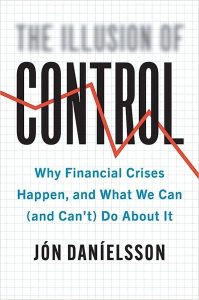In The Illusion of Control: Why Financial Crises Happen, and What We Can (and Can’t) Do About It, Jón Daníelsson challenges conventional assumptions around risk and regulation used to prevent financial crises. Drawing from past and recent crises, this sharp, insightful book makes a strong case for policymakers to reappraise the current safeguarding paradigm, writes William Quinn.
The Illusion of Control: Why Financial Crises Happen, and What We Can (and Can’t) Do About It. Jón Daníelsson. Yale University Press. 2022.
 The COVID crisis, the failure of Silicon Valley Bank, and the collapse of Credit Suisse have clarified the modern approach to financial crisis prevention, which largely consists of repeating the better parts of the 2008 response as quickly as possible. At the slightest hint of problems in the sector, regulators will find money to prevent banks from failing and cover their deposits. On the one hand, swift action in the moment (hopefully) averts another global financial crisis. On the other hand, it loads the financial system with enormous amounts of moral hazard. The privatisation of gains and socialisation of losses, considered a necessary injustice in 2008, is now official government policy. Might there be a better way to prevent crises?
The COVID crisis, the failure of Silicon Valley Bank, and the collapse of Credit Suisse have clarified the modern approach to financial crisis prevention, which largely consists of repeating the better parts of the 2008 response as quickly as possible. At the slightest hint of problems in the sector, regulators will find money to prevent banks from failing and cover their deposits. On the one hand, swift action in the moment (hopefully) averts another global financial crisis. On the other hand, it loads the financial system with enormous amounts of moral hazard. The privatisation of gains and socialisation of losses, considered a necessary injustice in 2008, is now official government policy. Might there be a better way to prevent crises?
The word ‘risk’ is used so freely in finance that it is easy forget how nebulous it is.
Jón Daníelsson’s excellent The Illusion of Control tackles this question through a highly accessible exploration of the nature of financial risk and the purpose of financial regulation. The word “risk” is used so freely in finance that it is easy forget how nebulous it is: it only has a meaning with respect to a specific outcome that one wishes to avoid. In financial regulation, the key risk to be managed is systemic risk. The goal is to avoid economically significant crises without unnecessarily restricting economic growth.
Daníelsson argues that the current paradigm of financial regulation has lost sight of this goal. Much of it is based on trying to quantify risk, then making banks follow a prescriptive set of rules based on the resulting measurements. But this strategy has significant problems. First, risk measures are based on past data, so they only work when the past is a reliable predictor of the future. Daníelsson compares this task to “driving while looking into the rearview mirror”. This problem is neatly illustrated by the European Central Bank’s composite indicator of systemic stress (CISS), which reported that the risk of a crisis was very low on the eve of the 2008 crisis, but very high when the crisis was over.
Risk measures are based on past data, so they only work when the past is a reliable predictor of the future.
Second, banks are regulated independently, resulting in a fallacy of composition. The focus is on ensuring the constituent parts of the system are safe, and hoping that this makes the overall system safe. This limitation is well understood, hence widespread calls for macroprudential regulation over the past 15 years. But Daníelsson argues that this is still mostly just talk, and financial regulation is still not macroprudential in practice.
Third, model risk – the possibility that your method of measuring risk is fundamentally flawed in ways that you don’t fully understand – is implicitly assumed to be negligible. The solution to model risk is to ensure that banks are not all using the same models, so that the failure of one risk management strategy does not collapse the entire system. The “most potent force of financial stability”, according to Daníelsson, is methodological diversity. Prescriptive financial regulation has the opposite effect: it enforces uniformity.
The ‘most potent force of financial stability’, according to Daníelsson, is methodological diversity.
The final problem with the current paradigm, and the one that is discussed most thoroughly, is that it does not account for the fact that financial regulation is endogenous. The act of observing, measuring, and legislating for the risk in a system significantly affects the risk in that system. As Goodhart’s Law states, historically useful measures often cease to be useful when they start to be treated as a target. When regulators do not appreciate their own endogeneity, measures intended to prevent a crisis can make a crisis more likely.
Suppose, for example, that financial regulation is focused on minimising volatility. To comply with regulation, banks will reduce the types of risk captured in the volatility measure while increasing the types of risk that it misses. When volatility is low, regulators will signal to banks that it is safe to extend more credit, increasing the true level of systemic risk in the system. The result, as Daníelsson and his co-authors have shown elsewhere, is that low volatility is a useful predictor of financial crises.
Volatility is a particularly poor measure of risk, but this critique applies universally. All risk measures, and all combinations of risk measures, are imperfect: they will always fail to account for some hidden type of risk. When banks are focused on maximising profits subject to complying with a prescribed set of risk measures, they will always eventually increase the exact type of risk those measures miss. Again, the major problem is uniformity – every bank is following the same set of regulations, so every bank is exposed to the same type of shock. When the financial system falls, it falls hard.
If these are the problems with financial regulation as it currently exists, what is the alternative? Daníelsson proposes five core principles. Regulators should focus on endogenous risk – the risk created by the financial and political system itself. Crises are more likely to be caused by excessive leverage, regulatory failure, or misguided policy than they are to be caused by viruses, wars, or natural disasters. Quantitative risk measures should be used with caution and an acute awareness of their limitations. Regulators should remember the fundamental goal of maximising economic growth while minimising the cost of systemic crises. They should prevent each element of regulation from retreating into its own silo, focused on achieving a narrowly defined goal while losing sight of the bigger picture. But they should also resist groupthink and encourage ideological diversity.
Regulators should remember the fundamental goal of maximising economic growth while minimising the cost of systemic crises.
The most notable omission from the book is a fuller discussion of incentives and liability. The fact that banks will always want to take more risk than regulators allow is treated as immutable. But modern banks are almost all limited liability corporations: a business structure specifically designed to allow owners to take risks they wouldn’t take if their own money was at stake. Historically, bankers have behaved very differently when faced with a different incentive structure, and this has resulted in eras with very few systemic crises. Daníelsson has discussed these issues thoughtfully elsewhere, but I feel they would have been worth including here.
Nevertheless, it is an exceptional book, distilling the author’s considerable experience into a sharp, insightful, entertaining package. For academics, the use of colourful examples from outside finance to illustrate important concepts makes it excellent for teaching. But it is really a call to action, and the true intended audience is policymakers. If its lessons are applied, perhaps financial regulation can aspire to something better than speed-running the 2008 response every few years.
Note: This review gives the views of the author, and not the position of the LSE Review of Books blog, or of the London School of Economics and Political Science. The LSE RB blog may receive a small commission if you choose to make a purchase through the above Amazon affiliate link. This is entirely independent of the coverage of the book on LSE Review of Books.
Main Image: kora_sun on Shutterstock.
Read an article by Jón Daníelsson, “The illusion of control: why the financial sector is more vulnerable than ever to a financial crisis” from January 2023 in LSE Research for the World.







1 Comments